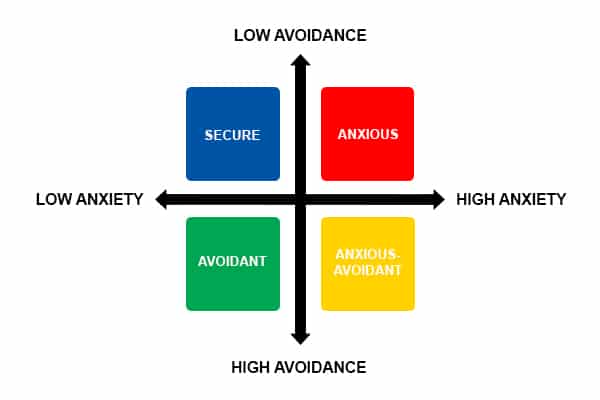Distinct methods of interacting and responding in relationships are traits of different attachment style. The interactions between young children and their parents are the focus of these attachment patterns during this time.
A term used to characterise patterns of attachment in romantic relationships in maturity is attachment style. As attachment theory and research developed throughout the 1960s and 1970s, the idea of attachment styles developed. There are currently four primary attachment styles that psychologists commonly recognise.
Table of Contents
What Is Attachment?
A unique kind of emotional connection known as attachment entails a sharing of comfort, caring, and pleasure. Although the foundations of attachment study can be found in Freud’s thoughts on love, another researcher is typically recognised as the originator of attachment theory.
The notion of attachment was thoroughly researched by John Bowlby, who defined it as a “lasting psychological bond between human beings.” Bowlby agreed with the psychoanalytic theory that early events in childhood have a significant impact on subsequent development and behaviour.
Early attachment patterns are formed in childhood through the caregiver/infant bond. Additionally, Bowlby thought that attachment had an evolutionary component and helped people survive.
Attachment Style Theory
The attachment theory, which was developed by Mary Ainsworth and was founded by psychotherapist John Bowlby in the 1950s, describes how your relationship with your primary caregivers lays the groundwork for how you negotiate relationships in the rest of your life.
According to the theory, there are four types of attachment styles:
- secure
- avoidant
- anxious
- disorganized
Insecure attachment patterns are avoidant, anxious, and unorganized.
A child is more likely to have a secure attachment type if they can constantly rely on their parents to meet their needs as they get older. Relationships will be seen by them as a secure setting where they are free to express their emotions.
On the other side, if a child has a tense relationship with their caretakers, insecure attachment styles develop. This occurs when the child realises they might not be able to rely on others to provide their comfort and fundamental requirements.

The Four Types Of Attachment Style
Secure Attachment Style
The capacity to establish solid, lasting relationships is what defines secure attachment style.
Being able to seek comfort or affirmation without fear of retaliation from your caretakers as a youngster will lead to a stable attachment.
In the end, your early contacts made you feel secure, comprehended, reassured, and appreciated.
Secure attachment behaviour is indicated by:
- The capacity to control your emotions
- Simple to trust others
- Strong communication abilities
- Being able to ask for emotional help
- At ease being by myself
- Able to maintain tight friendships
- Self-reflection skills in relationships
Because of this, individuals with secure attachment patterns frequently manage relationships well. They tend to be caring, trusting, and positive toward their spouses.
Avoidant Attachment Style
An insecure attachment type known as the avoidant attachment style is characterised by a fear of intimacy. Relationships can suffocate those with an avoidant attachment style since they often find it difficult to trust or grow close to people. As they like to be independent and rely on themselves, they frequently keep some distance from or are largely emotionally inaccessible to their spouses.
Dismissive-avoidant attachment, another name for avoidant attachment, often corresponds to the anxious-avoidant attachment type seen in young children. According to Hazan and Shaver, the avoidant attachment type affects about 25% of individuals.
Anxious Attachment Style
An additional form of insecure attachment called anxious attachment style, often known as anxious-ambivalent or anxious-preoccupied, is characterised by:
- dread of being rejected
- reliance on a partner for approval and emotional control
- fear of desertion
In general, anxious attachment, often referred to as anxious-preoccupied attachment, or anxious-resistant attachment type, is seen in children. According to the research of Hazan and Shaver, the anxious attachment type affects roughly 19% of adults.
Disorganized or Anxious Avoidant Attachment
The anxious and avoidant attachment styles are combined to create the fearful-avoidant attachment style. People who have a fearful-avoidant attachment simultaneously seek affection and actively try to avoid it. They are hesitant to enter into a committed relationship, yet they also really want to be loved by others.
Disorganized attachment, commonly referred to as fearful-avoidant attachment, is a very uncommon and understudied attachment style. However, we are aware that it has serious psychological and interpersonal hazards, including heightened sexual behaviour, a higher chance of domestic violence, and overall problems in emotion regulation.
Popular Reads
Learn more about the human mind, discover yourself and remain motivated with Evolve! If you liked our article, try the Evolve App to help you move on and focus on your growth. Evolve has a range of guided audios that help you proactively manage stress, reduce anxiety and make mindfulness light and joyful, so you can be balanced at anytime! The Evolve app is now live globally on Android and Apple. Click here to try it for free!
